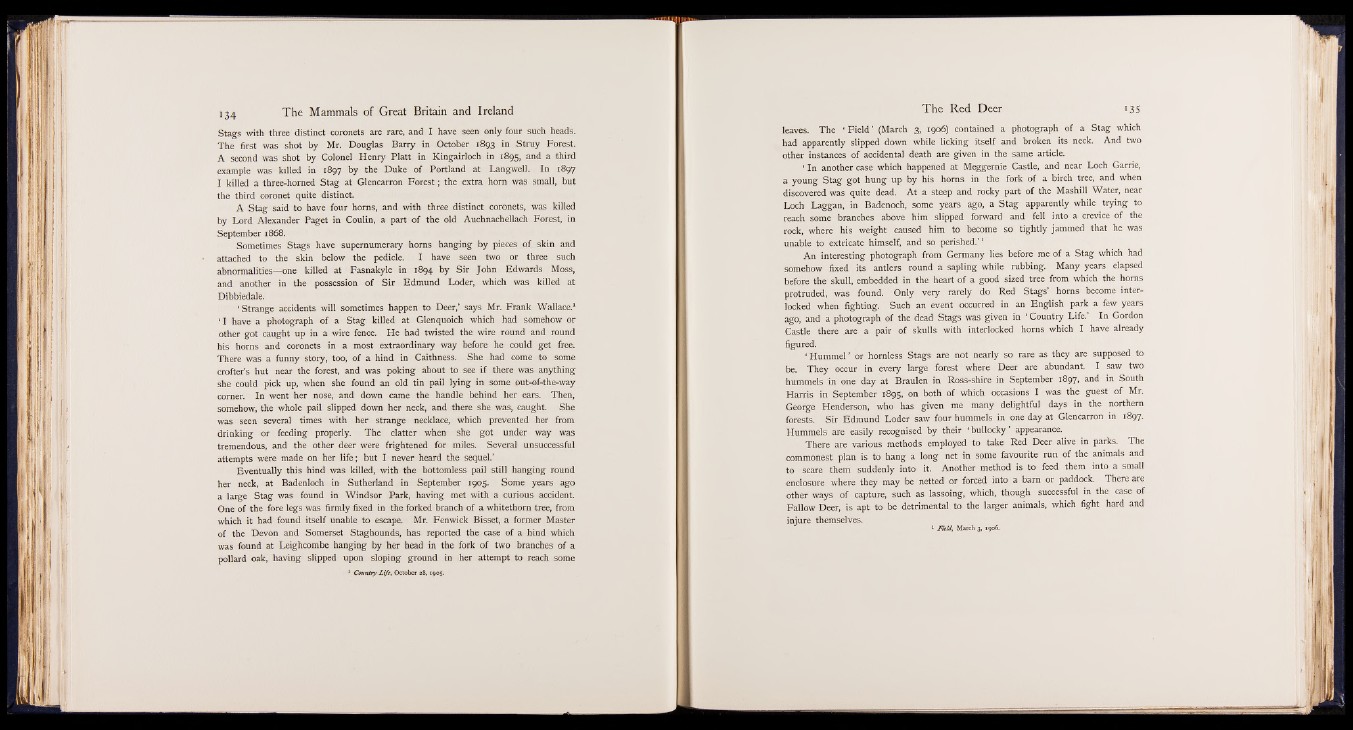
134
Stags with three distinct coronets are rare, and I have seen only four such heads.
The first was shot by Mr. Douglas Barry in October 1893 in Struy Forest.
A second was shot by Colonel Henry Platt in Kingairloch in 1895, and a third
example was killed in 1897 by the Duke of Portland at Langwell. In 1897
I killed a three-horned Stag at Glencarron Forest; the extra horn was small, but
the third coronet quite distinct.
A Stag said to have four horns, and with three distinct coronets, was killed
by Lord Alexander Paget in Coulin, a part of the old Auchnachellach Forest, in
September 1868.
Sometimes Stags have supernumerary horns hanging by pieces of skin and
attached to the skin below the pedicle. I have seen two or three such
abnormalities— one killed at Fasnakyle in 1894 by Sir John Edwards Moss,
and another in the possession of Sir Edmund Loder, which was killed at
Dibbiedale.
‘ Strange accidents will sometimes happen to Deer,’ says Mr. Frank Wallace.1
‘ I have a photograph of a Stag killed at Glenquoich which had somehow or
other got caught up in a wire fence. He had twisted the wire round and round
his horns and coronets in a most extraordinary way before he could get free.
There was a funny story, too, of a hind in Caithness. She had come to some
crofter’s hut near the forest, and was poking about to see if there was anything
she could pick up, when she found an old tin pail lying in some out-of-the-way
corner. In went her nose, and down came the handle behind her ears. Then,
somehow, the whole pail slipped down her neck, and there she was, caught. She
was seen several times with her strange necklace, which prevented her from
drinking or feeding properly. The clatter when she got under way was
tremendous, and the other deer were frightened for miles. Several unsuccessful
attempts were made on her life; but I never heard the sequel.’
Eventually this hind was killed, with the bottomless pail still hanging round
her neck, at Badenloch in Sutherland in September 1905. Some years ago
a large Stag was found in Windsor Park, having met with a curious accident.
One of the fore legs was firmly fixed in the forked branch of a whitethorn tree, from
which it had found itself unable to escape. Mr. Fenwick Bisset, a former Master
of the Devon and Somerset Staghounds, has reported the case of a hind which
was found at Leighcombe hanging by her head in the fork of two branches of a
pollard oak, having slipped upon sloping ground in her attempt to reach some
1 Country L ife, October 28,1905.
leaves. The ‘ Field ’ (March 3, 1906) contained a photograph of a Stag which
had apparently slipped down while licking itself and broken its neck. And two
other instances of accidental death are given in the same article.
‘ In another case which happened at Meggernie Castle, and near Loch Garrie,
a young Stag got hung up by his horns in the fork of a birch tree, and when
discovered was quite dead. At a steep and rocky part of the Mashill Water, near
Loch Laggan, in Badenoch, some years ago, a Stag apparently while trying to
reach some branches above him slipped forward and fell into a crevice of the
rock, where his weight caused him to become so tightly jammed that he was
unable to extricate himself, and so perished.’ 1
An interesting photograph from Germany lies before me of a Stag which had
somehow fixed its antlers round a sapling while rubbing. Many years elapsed
before the skull, embedded in the heart of a good sized tree from which the horns
protruded, was found. Only very rarely do Red Stags’ horns become interlocked
when fighting. Such an event occurred in an English park a few years
ago, and a photograph of the dead Stags was given in ‘ Country Life.’ In Gordon
Castle there .are a pair of skulls with interlocked horns which I have already
figured.
‘ Hummel’ or hornless Stags are not nearly so rare as they are supposed to
be. They occur in every large forest where Deer are abundant. I saw two
hummels in one day at Braulen in Ross-shire in September 1897, and in South
Harris in September 1895, on both of which occasions I was the guest of Mr.
George Henderson, who has given me many delightful days in the northern
forests. Sir Edmund Loder saw four hummels in one day at Glencarron in 1897.
Hummels are easily recognised by their ‘ bullocky ’ appearance.
There are various methods employed to take Red Deer alive in parks. The
commonest plan is to hang a long net in some favourite run of the animals and
to scare them suddenly into it. Another method is to feed them into a small
enclosure where they may be netted or forced into a barn or paddock. There are
other ways of capture, such as lassoing, which, though successful in the case of
Fallow Deer, is apt to be detrimental to the larger animals, which fight hard and
injure themselves.
1 Field, March 3, 1906.